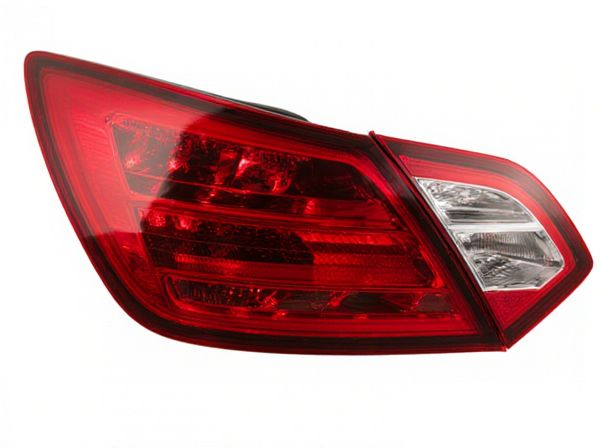
Photo illustration: Sequential vs Static Taillight
Sequential taillights create a dynamic lighting effect by illuminating LEDs in a flowing sequence, enhancing vehicle visibility and aesthetic appeal. Static taillights, on the other hand, illuminate all LEDs simultaneously, providing consistent and uniform brightness for reliable signaling. You can choose sequential taillights to add modern style to your vehicle or static taillights for straightforward functionality and durability.
Table of Comparison
| Feature | Sequential Taillight | Static Taillight |
|---|---|---|
| Lighting Style | Dynamic, flowing light sequence | Fixed, constant illumination |
| Visual Impact | Enhanced visibility and modern look | Traditional and simple appearance |
| Functionality | Directional signaling with movement effect | Basic signaling without motion effect |
| Energy Consumption | Moderate, uses multiple LEDs | Lower, fewer LEDs involved |
| Cost | Higher due to advanced technology | Lower, standard technology |
| Installation Complexity | Requires advanced wiring and controllers | Simple wiring and installation |
| Maintenance | Potentially higher, due to electronic components | Lower, fewer components |
Introduction to Taillight Technologies
Taillight technologies have evolved to enhance vehicle safety and aesthetics, with sequential and static designs being the primary types. Sequential taillights illuminate individual segments in a flowing pattern, improving signal visibility and driver communication. Static taillights maintain a consistent illumination pattern, offering simplicity and reliability in various lighting conditions.
What Are Static Taillights?
Static taillights consist of fixed LED or incandescent bulbs that illuminate steadily to signal braking or nighttime visibility without any dynamic lighting effects. These taillights deliver consistent brightness and reliable performance, making them a common choice for standard vehicle safety lighting. Unlike sequential taillights, static taillights do not feature progressive illumination patterns and maintain a uniform light display.
Understanding Sequential Taillights
Sequential taillights feature LEDs that illuminate in a dynamic, flowing pattern to indicate turning direction, enhancing visibility and safety compared to static taillights. These LEDs light up sequentially from the inner side toward the outer edge, providing a clear visual signal to other drivers. This advanced lighting technology complies with automotive safety standards while offering a modern aesthetic appeal for various vehicle models.
Visual Differences: Sequential vs Static
Sequential taillights feature dynamic lighting effects where individual LEDs illuminate in a progressive sequence, creating a flowing motion that enhances vehicle visibility and modern aesthetics. Static taillights, by contrast, display all LEDs simultaneously without movement, providing a consistent but less eye-catching light pattern. The visual difference lies in the sequential taillight's animated glow that signals braking or turning more clearly compared to the steady illumination of static taillights.
Safety and Visibility Benefits
Sequential taillights significantly enhance safety by providing dynamic, eye-catching signals that improve driver reaction time. Their illuminated progression clearly indicates turning direction, reducing the risk of rear-end collisions in low-visibility conditions. Static taillights, while reliable, offer less distinctive signaling, making sequential designs superior for maximizing visibility and communicating driver intentions effectively.
Design and Aesthetics Comparison
Sequential taillights feature dynamic lighting patterns that create a flowing motion effect, elevating vehicle aesthetics with a modern and high-tech appearance. Static taillights rely on fixed illumination, offering a more traditional and consistent look that emphasizes simplicity and clarity. The choice between sequential and static designs significantly impacts a car's rear-end visual appeal, blending functionality with stylistic expression.
Installation and Maintenance
Sequential taillights require precise wiring and often specialized connectors during installation to ensure proper sequential lighting patterns, making the process more complex than static taillights. Static taillights offer simpler installation with standard wiring and fewer components, reducing time and potential errors. Maintenance for sequential taillights may involve higher costs and technical adjustments to electronic controllers, whereas static taillight maintenance typically involves straightforward bulb or LED replacements.
Cost Considerations
Sequential taillights generally incur higher costs due to more complex electronics and manufacturing processes compared to static taillights, which use simpler, fixed LED or bulb arrangements. The increased price of sequential taillights reflects factors such as programmable microcontrollers and advanced circuitry that enable dynamic lighting effects. While static taillights are more budget-friendly and easier to maintain, sequential taillights offer enhanced visibility and modern aesthetics, influencing the cost-benefit analysis for vehicle owners and manufacturers.
Legal and Regulatory Aspects
Sequential taillights, which illuminate in a flowing sequence, often face stricter legal scrutiny compared to static taillights due to differing regulations across countries regarding brightness, light patterns, and potential driver distraction. Many jurisdictions require sequential taillights to meet specific standards such as SAE (Society of Automotive Engineers) or ECE (Economic Commission for Europe) certification to ensure compliance with safety norms. Static taillights generally have more universally accepted regulations, making them easier to certify for sale and road use in a broader range of markets.
Choosing the Best Taillight for Your Vehicle
Sequential taillights feature dynamic light patterns that enhance vehicle visibility and modern aesthetics, while static taillights offer consistent illumination with simpler installation and lower cost. When choosing the best taillight for your vehicle, consider factors such as compatibility with your car model, local road safety regulations, and your preference for style versus functionality. Prioritize taillights with high-quality LED technology for improved brightness, energy efficiency, and longevity.
 caratoz.com
caratoz.com